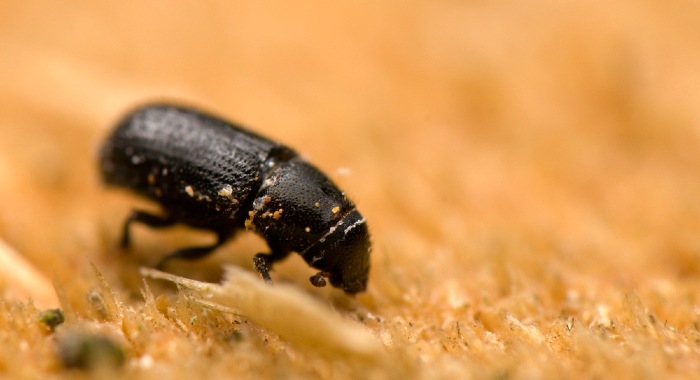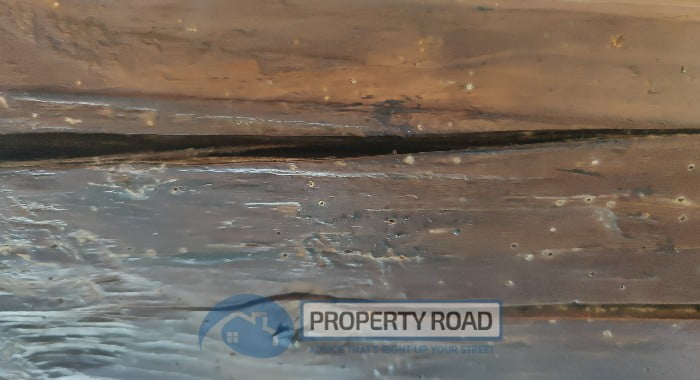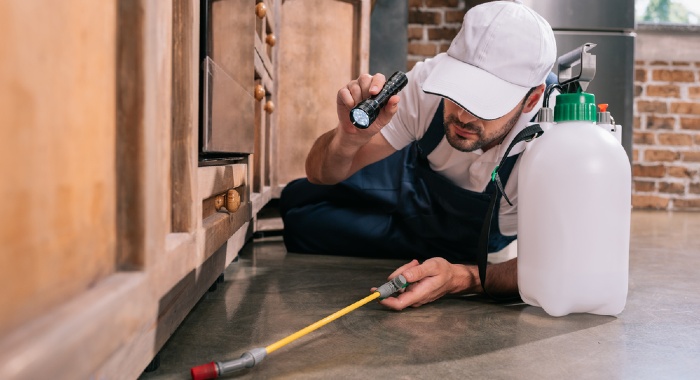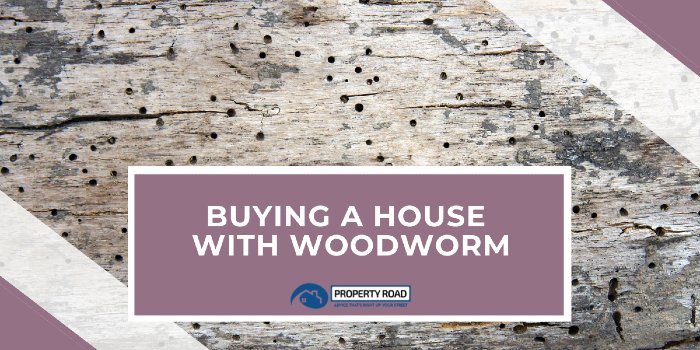Buying a house with woodworm may not be ideal, but it is possible to find good deals on properties that have this issue – because the seller will be keen to sell with little competition from other buyers.
And, despite the name, woodworm isn’t a worm – it’s a type of beetle that infests wood, and its larvae can cause extensive damage to wooden structures.
While the presence of woodworm is not necessarily a deal-breaker, it is important to get a professional opinion on the extent of the infestation and whether treatment is necessary.
Here are a few things to keep in mind if you’re considering buying a property with woodworm:
- Woodworm is more common in older properties, so if you’re buying a period home, it’s important to be extra vigilant;
- Woodworm tends to like damp properties, so check for damp or humid conditions;
- Inspect the property carefully for any signs of woodworm, such as small holes in woodwork or dust coming from these holes;
- If you do find woodworm, get a professional opinion on the extent of the infestation and whether treatment is necessary;
- Bear in mind that woodworm treatment can be costly, so factor this into your decision-making;
- Your mortgage in principle might be withdrawn if you find woodworm – and lenders may think twice about lending on an infested property.
Ultimately, whether you buy a property with woodworm is up to you.
However, it’s important to be aware of the potential risks and make sure you have all the information you need before deciding.
When we bought our current home we had noticed signs of woodworm on the exposed floorboards of the bedroom and the exposed beam of a sitting room. We questioned the sellers about it and they informed us they’d had it checked and it was historical and no longer an issue.
Still, we needed to get some damp patches checked out anyway so we commissioned a damp & timber report. The surveyor checked the timbers for woodworm and confirmed there was a previous infestation but it was no longer active and should not concern us.
What is woodworm, and why is it a problem?

Woodworm is a general term used to describe the larvae of wood-boring beetles; they include:
- Deathwatch Beetle (Xestobium rufovillosum);
- Common Furniture Beetle (Anobium punctatum);
- Powder Post Beetle (Lyctus brunneus);
- House Longhorn Beetle (Hylotrupes bajulus).
The most common type of woodworm in the UK is the Common Furniture Beetle, and woodworm is a problem because the larvae feed on wood, causing damage as they tunnel through it.
If left untreated, they can cause serious structural damage to a property – we discuss why this issue needs to be taken seriously later.
Aside from structural issues, a study by Sánchez-Bernal et al., (2020) recorded cases of dermatitis tied to contact with woodworm-infested furniture.
If you do find evidence of woodworm, it is important to have the property inspected by a professional before making an offer.
However, it’s important to appreciate that with the right treatment, woodworm can be controlled and does not necessarily mean that the property is uninhabitable.
Also, woodworm does not cause immediate damage – it can take months or even years for the larvae to mature and start causing problems.
If your infestation is minor, that’s not always a serious problem to resolve, though you will need to have it investigated and then treated. Not treating the infestation can lead to serious problems because woodworm can infest:
- floorboards;
- joists;
- doors;
- skirting;
- windows;
- rafters;
- other structural timbers.
The right treatment should see a woodworm infestation being controlled and stopped.
However, you should appreciate that the issue may not be completely resolved – there is always a risk of re-infestation.
To minimise the risk of re-infestation, it’s important to address any damp issues in the property as well as carry out regular inspections.
This is what we are doing in our property to prevent the previous woodworm infestation from coming back. We have several damp problems and are working our way through resolving each one.
Thankfully, the previous woodworm infestation appears to have been caught fairly early so, as long as we get on top of the damp issues, we hope to be ok!
How to check for woodworm

There are several signs a property might have woodwork, and as you inspect a property, you should take note of:
- Small round holes in the wood, typically 2-4mm in diameter;
- Fine powdery dust around the holes (this is known as frass);
- Tunnels or galleries in the wood.
You should mention this to the homeowner and ensure you have a full survey done by a qualified surveyor. A simple home survey is unlikely to find the problem.
That is, of course, unless the infestation is present in exposed timbers, as it was in the property we bought.
In our case, even we could see the evidence of woodworm tunnels in our exposed floorboards and small woodworm holes in an exposed beam. However, a survey was still important for us so that the whole house could be checked.
With a full survey, there will be confirmation of whether woodworm is present and, if so, assess the extent of the infestation. Be aware that if the surveyor says there isn’t an infestation and you find there is and prove they should have found it, you may be able to claim the costs of fixing the problem from the surveyor.
You also need to know that woodworm does not spread quickly, and infestations tend to be localised.
How do surveyors check for woodworm?
Most surveyors will check for woodworm by:
- Tapping on the timber and listening for a hollow sound will indicate that the timber has been damaged by woodworm;
- Use a small borescope to look inside the timber for signs of damage.
If they suspect that there is woodworm present, they will recommend that you have the property treated by a professional.
It’s also important to remember that woodworm is not always easy to spot.
For this reason, when buying a property, it is worth arranging for a surveyor to check for woodworm (and other defects) because this will give you peace of mind and could save you a lot of money in the long run.
If there is a woodworm infestation, it will be either:
- Historic: An historic infestation has signs of timber damage caused by a previous infestation – though there is no activity currently.
- Active: An active infestation will see larvae and eggs – and possibly beetles – being active in the home’s timber. This is a serious problem to resolve, and you may need to consider what might have caused it, such as damp, dry or wet rot, leaks, and structural faults.
Buying A Property? FREE Step-By-Step Platform
Buying a house with woodworm
If you’re buying a house in the UK, woodworm should definitely be on your radar.
When a woodworm infestation is severe, the surveyor should pick it up during their inspection, but if the infestation is small or in its early stages, the surveyor may not spot it.
Therefore, it’s always a good idea to do your own thorough inspection of the property before making an offer. This will be important if the building is old or you decide not to have a full survey done.
Take your time if you do undertake an inspection – and ask (lots of) questions of the homeowner.
Start by checking any exposed wood in the property like we did. You can also ask the seller if any of the carpets are able to be pulled back for a deeper inspection – but don’t be offended if they refuse!
We also make a point of sticking our heads up into the loft space or eaves. There are usually plenty of exposed beams you can check up there. If in doubt, do as we did and commission a damp and timber report.
Is woodworm damage covered by house insurance?

Most standard home insurance policies will not cover woodworm damage, but it is always best to check with your insurer to be sure. However, you may experiment that if you try to make a claim, the cover will be invalidated.
Is the previous owner responsible for paying to repair woodworm?
Not if they tell you there is, or has been, woodworm in the house.
And not if your surveyor hasn’t picked up on it.
If you find woodworm shortly after buying a property, it is important to have the infestation treated as soon as possible.
You should discuss the situation with the previous owner and see if they are willing to contribute to those costs – if they knew of an infestation.
If they are unwilling to do so, you may need to take legal action to recover your repair bill.
This is one of the instances when you will have to check very carefully the documentation the seller provided – their statement about the property’s condition needs to be honest and true.
It’s always worth speaking to your solicitor on this issue before raising it with the seller to see where you stand.
It might be difficult to assess when exactly the woodworm issue took hold, but an expert surveyor may be able to give an indication.
How much does it cost to repair woodworm?
The cost of repairing woodworm damage will depend on the extent of the infestation.
If the infestation is limited to a small area, treatment may only cost a few hundred pounds – and you could do this yourself with specialist sprays. There is no guarantee that you will resolve the problem and that it won’t return.
However, if the damage is more widespread, the costs can quickly mount up – into the thousands of pounds.
As well as the cost of the treatment itself, you may also need to factor in the cost of repairing any other damage that has been done to the property.
For example, if woodworm has caused structural damage, you may need to hire a builder to make repairs.
This could mean extensive work being carried out, for example, to replace woodworm-infested beams.
And that could get very costly indeed.
How can woodworm be treated?

The most common treatment is to inject an insecticide into the affected timbers. This will kill the larvae and prevent further damage from occurring.
If you are buying a property that has woodworm, it is important to factor in the cost of treatment when negotiating the purchase price.
This will ensure that you are not left out of pocket if repairs are required.
However, as mentioned, you cannot ignore a woodworm infestation because it will only get worse and could damage your property’s integrity.
This is because the larvae tunnel through wood, weakening beams and joists. In extreme cases, woodworm infestations can lead to collapses.
According to Gilfillan & Gilbert (2001), a superficial examination of woodworm-infested timber may be deceiving. This is because the internal tunnels the larvae make are much more severe in reality.
In other words, when you notice the holes, the damage may already be permanent. This can be a fatal blow, especially to homes with historical value.
Aside from the risk of structural damage, woodworm can also have an impact on the value of your property.
Properties with woodworm are often seen as being less desirable, which can make them harder to sell in the future.
Is having woodworm a reason not to buy a house?
No, woodworm is not a reason not to buy a house.
However, it is important to be aware of the potential cost of treating an infestation – and use this as a discount on the house price.
This will also help ensure that you are not left out of pocket if repairs are required.
Tips on buying a property with woodworm in the UK
As a reminder, these tips will help you decide whether buying a house with woodworm in the UK is worth it or not.
What is woodworm?
Woodworm is a type of beetle which infests wooden objects, causing damage as the larvae bore through the wood.
How can you tell if a property has woodworm?
If you suspect that a property has woodworm, it is important to have it inspected by a qualified surveyor. They will be able to confirm whether woodworm is present and if so, assess the extent of the infestation.
What should you do if you find woodworm on your property?
If you find woodworm on your property, it is important to have the infestation treated as soon as possible. If left untreated, woodworm can cause serious damage to the structural integrity of the property.
How much does it cost to repair woodworm damage?
The cost of repairing woodworm damage will depend on the extent of the infestation. You can repair the infestation yourself if it is minor; otherwise, you will be spending £500-£1,000 and possibly more for a severe infestation, especially if you need to get the builders in for structural repairs.
Buying a house with woodworm
For most home buyers, the presence of woodworm will end their interest immediately. However, it may be worth considering whether you should buy the property because there will be less competition – which means the price will be lower.
And the house seller is also likely to accept a lower offer.
You will need to treat the infestation, and the cost of doing so might be reasonable, which would make the house purchase a good investment.
The bottom line is that you need to know the extent of the infestation and be confident you can cure it, so there isn’t a recurrence. This also means that you need to keep your home well-ventilated to avoid another infestation.
Our home has a positive pressure ventilation system to help reduce the chances of another infestation and we hired a surveyor to do a damp and timber check before we committed to buying it. This gave us the peace of mind that the woodworm infestation in our home is historical and non-active.
You will also have to be honest with your lender and will need to prove the woodworm infestation is going to be (or has been dealt with) to get a mortgage.
Knowing what a woodworm infestation is and how to take steps to resolve it means you will be buying a home at a discount without worrying that woodworm will return.





